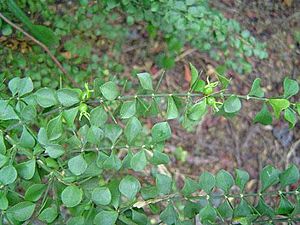Tropical lilythorn facts for kids
Quick facts for kids Tropical lilythorn |
|
|---|---|
 |
|
| Conservation status | |
| Scientific classification | |
| Genus: |
Catesbaea
|
| Species: |
melanocarpa
|
Catesbaea melanocarpa, also called the tropical lilythorn, is a very rare flowering plant. It belongs to the coffee family. This special plant grows on five islands in the Caribbean Sea. These islands are Puerto Rico, St. Croix in the United States Virgin Islands, Antigua, Barbuda, and one island in Guadeloupe. Sadly, the tropical lilythorn is in danger because its home is disappearing.
What Does the Tropical Lilythorn Look Like?
The tropical lilythorn is a shrub, which is like a small tree. It can grow up to three meters (about 10 feet) tall. Its branches spread out and have sharp spines. These spines can be as long as two centimeters (almost an inch).
Between the spines, you'll find groups of green leaves. Each leaf is small, about 2.5 centimeters long and 1.5 centimeters wide. The plant also has pretty white flowers. These flowers are shaped like a funnel and are about one centimeter long. They grow alone or in pairs where the leaves meet the stem. After the flowers, the plant produces round, black fruits.
Where Does This Plant Live?
The tropical lilythorn was first found on the island of Antigua. Today, it is very rare there. We don't know much about how many plants are left on Barbuda and Guadeloupe.
In Cabo Rojo, Puerto Rico, there is only one wild plant left. It lives on private land that has been changed a lot by people. On St. Croix, there are about 100 plants remaining. Because there are so few of these plants in the United States islands, it was listed as an endangered species in 1999. This means it has a high chance of becoming extinct.
Why Is the Tropical Lilythorn in Danger?
The tropical lilythorn is at high risk of extinction for a few reasons.
- Habitat Loss: Its natural home is being destroyed. This happens when people build new houses or places for tourists.
- Fires: Fires can also burn down the areas where these plants live.
- Severe Weather: Strong storms like hurricanes can wipe out many plants at once. For example, after Hurricane Hugo in 1989, it was very hard to find the plant.
The tropical lilythorn grows in dry forests. These forests don't get as much rain as other places on the islands. They usually get about 100 centimeters (40 inches) of rain each year.


